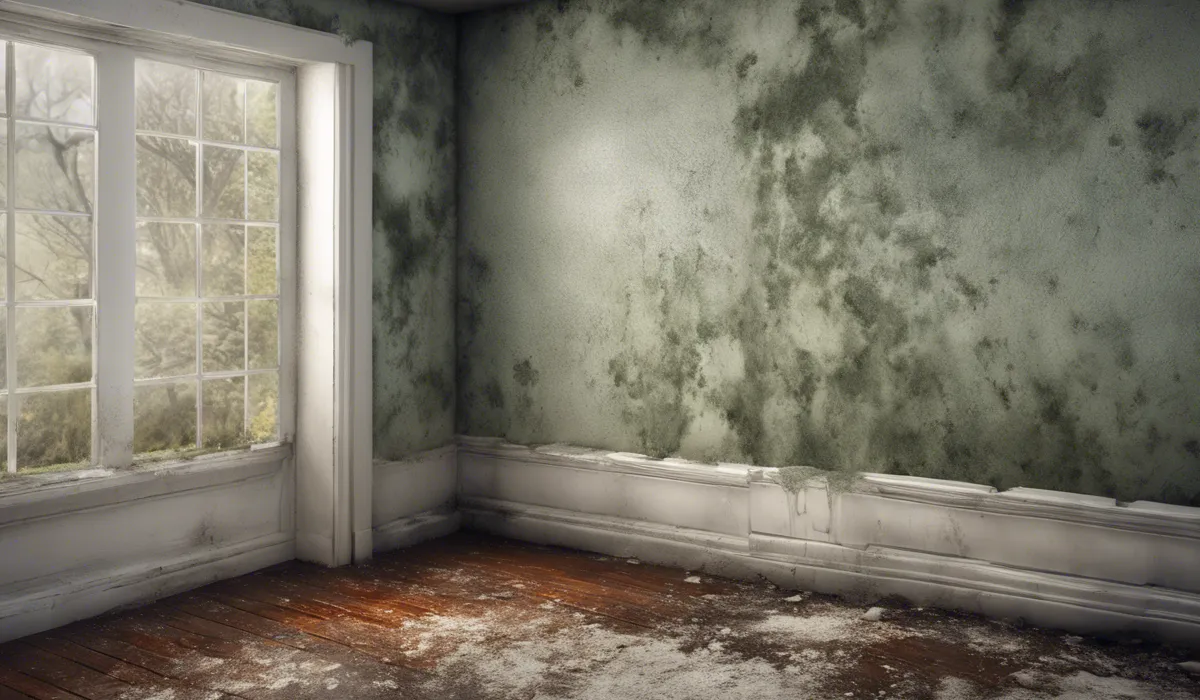Mold in a house is commonly caused by excess moisture, which can stem from leaks, high humidity, condensation, or poor ventilation. Damp areas like bathrooms and basements are particularly prone to mold growth.
Causes of Mold Related to Moisture Problems

High Humidity Levels in the Home
Mold thrives in moist environments, and high humidity in your home creates the perfect conditions for mold to grow.
When the air inside your house contains a lot of moisture, it can condense on cooler surfaces, such as walls and windows, providing a water source for mold.
Using dehumidifiers and ensuring good air circulation can help manage humidity levels and prevent mold growth.
Leaking Pipes and Plumbing Issues
Hidden leaks in your home’s plumbing can cause unseen mold growth. Water from leaky pipes can accumulate behind walls or under floors, leading to mold problems that are not immediately noticeable.
Regularly inspecting pipes for leaks and addressing any issues promptly can help prevent mold from taking hold in these areas.
Roof Leaks Allowing Water to Seep into the Home
A leaking roof can let water into your attic and walls, creating an environment where mold can flourish.
It’s important to inspect your roof regularly, especially after heavy storms, and to repair any damage quickly.
This proactive approach can save you from extensive mold problems and costly repairs down the line.
Poor Ventilation in Bathrooms and Kitchens
Bathrooms and kitchens are high-moisture areas in the home. Without proper ventilation, the humidity from showers, baths, and cooking can lead to mold growth.
Installing exhaust fans and using them during and after these activities can help reduce moisture and keep mold at bay.
Condensation on Cold Surfaces
Condensation forms when warm, moist air comes into contact with cold surfaces like windows or metal pipes. This moisture can create a breeding ground for mold.
Insulating these surfaces and reducing indoor humidity can help prevent condensation and mold growth.
Flooding or Water Damage That Was Not Properly Addressed
If your home has experienced flooding or significant water damage, it is crucial to dry out the affected areas thoroughly.
Mold can begin to grow within 24 to 48 hours after water exposure. Hiring professionals to ensure proper cleanup and drying can prevent mold from becoming a long-term problem.
Damp Basements or Crawl Spaces
Basements and crawl spaces tend to be naturally damp due to their location in the home. This dampness can lead to mold growth.
Using dehumidifiers, improving drainage, and sealing these areas from outside moisture can help keep them dry and mold-free.
Inadequate Drying of Carpets, Upholstery, or Materials After Getting Wet
When carpets, upholstery, or other materials become wet and are not dried quickly, mold can begin to grow.
It’s essential to dry these items thoroughly and, if necessary, seek professional cleaning services to ensure that no moisture is trapped.
Building Materials and Household Items That Attract Mold

Drywall and Wood That Retain Moisture
Materials like drywall and wood can absorb and retain moisture, providing an ideal environment for mold to grow.
Using mold-resistant varieties of these materials, especially in moisture-prone areas, can help prevent mold problems.
Wallpaper Glue That Provides a Food Source for Mold
The glue used to affix wallpaper can be a food source for mold. If wallpaper becomes damp, it can become a hotspot for mold growth.
Choosing alternative wall coverings or ensuring that wallpaper is well-sealed can mitigate this risk.
Insulation Materials That Have Become Wet
Wet insulation is a common culprit for mold growth. It’s important to prevent insulation from getting wet during installation and to check it periodically for signs of moisture.
If insulation does become wet, it should be replaced to prevent mold.
Carpeting That Absorbs Moisture and Debris
Carpets can trap moisture and organic debris, which can lead to mold growth. Regular vacuuming and deep cleaning are important, as well as addressing any spills or leaks quickly to prevent moisture from seeping into the carpet padding.
Furniture and Fabrics That Are Prone to Dampness
Upholstered furniture and fabrics can absorb moisture from the air and become breeding grounds for mold. Keeping these items clean and dry is crucial.
Consider using a dehumidifier in rooms with fabric-covered furniture to maintain a dry environment.
Cardboard and Paper Products That Hold Moisture
Cardboard boxes and paper products can absorb moisture and support mold growth. Storing these items in a dry, climate-controlled environment can prevent them from becoming moldy.
Ceiling Tiles That Have Been Exposed to Water
Ceiling tiles that have been water-damaged are susceptible to mold. It’s important to replace any water-damaged tiles and to fix the source of the leak to prevent further issues.
Lifestyle and Maintenance Factors

Lack of Regular Cleaning and Maintenance
Mold can accumulate in areas that are not regularly cleaned, especially if these areas are prone to moisture. Regular cleaning and maintenance can disrupt mold growth and keep your home healthy.
Insufficient Air Exchange and Poor Indoor Air Quality
Poor air circulation can lead to stagnant, humid air that supports mold growth. Ensuring that your home has good air exchange through proper ventilation can improve indoor air quality and reduce mold risks.
Overuse of Humidifiers or Not Monitoring Indoor Humidity Levels
While humidifiers can improve comfort, overusing them can raise humidity to levels that promote mold growth. It’s important to monitor indoor humidity and use humidifiers sparingly.
Storing Items in Damp Areas, Promoting Mold Growth
Storing items like clothing or books in damp areas like basements can lead to mold. Choose storage solutions that keep items off the ground and in dry, well-ventilated spaces.
Improperly Sealed Windows and Doors Allowing Moisture to Enter
Windows and doors that are not properly sealed can let in moisture, which can lead to mold around the frames. Regularly checking seals and weatherstripping can prevent this issue.
Failure to Address Water Leaks and Spills Quickly
Immediate action is required when water leaks or spills occur. The quicker you dry the affected area, the less chance there is for mold to grow. Always have a plan for dealing with unexpected water incidents to minimize mold risks.
Inefficient or Non-existent Exhaust Fans in High-Moisture Areas
Exhaust fans play a key role in removing moisture from areas like bathrooms and kitchens.
If these fans are not working properly, or if they are not installed, humidity can build up and lead to mold problems.
Ensuring that exhaust fans are efficient and used regularly can keep these high-moisture areas dry.
FAQs About Causes of Mold in a House
What is the primary cause of mold growth in a house?
The primary cause of mold growth in a house is excess moisture, which can come from leaks, high indoor humidity, condensation, or inadequate ventilation.
How can leaks lead to mold in a home?
Leaks can lead to mold by providing a constant source of moisture, which mold spores thrive on, especially when the leak is undetected and allows water to accumulate over time.
Why is high humidity in a house a concern for mold growth?
High humidity in a house raises the overall moisture level in the air, creating an environment conducive to mold growth, particularly in poorly ventilated areas.
Can condensation cause mold in homes?
Yes, condensation can cause mold in homes by providing moisture on surfaces where mold spores can settle and begin to grow.
Which areas in a house are most vulnerable to mold?
Damp areas like bathrooms and basements are most vulnerable to mold due to their typically higher levels of moisture and sometimes limited airflow.
Final Thoughts
Mold in homes primarily arises from persistent moisture issues. Such moisture can originate from various sources, including leaks, high indoor humidity levels, condensation challenges, and inadequate ventilation.
Locations particularly susceptible to mold, such as bathrooms and basements, often experience damp conditions that facilitate mold proliferation.
